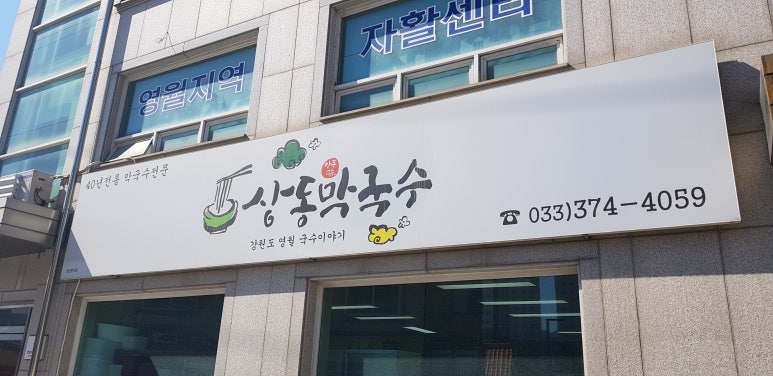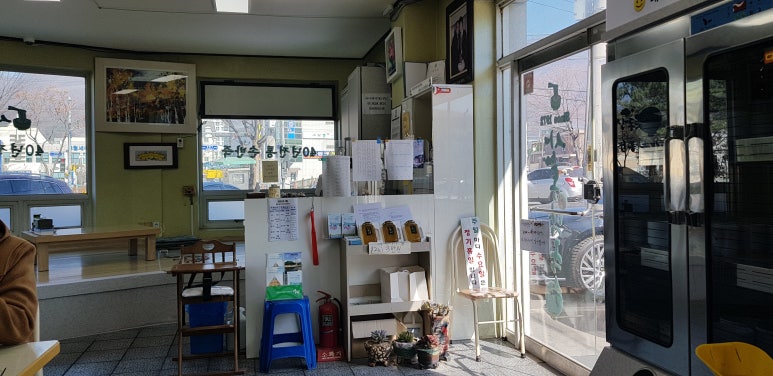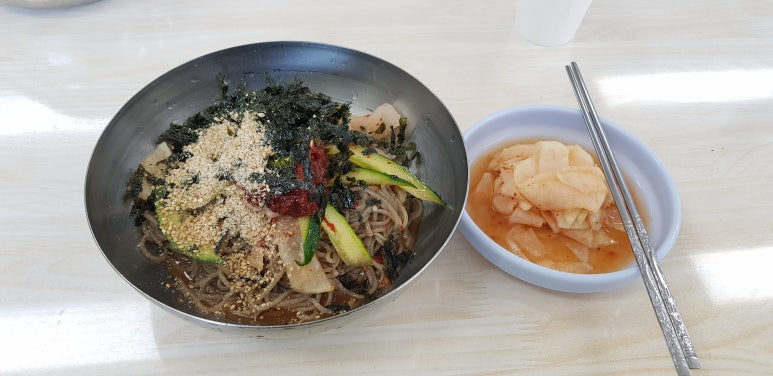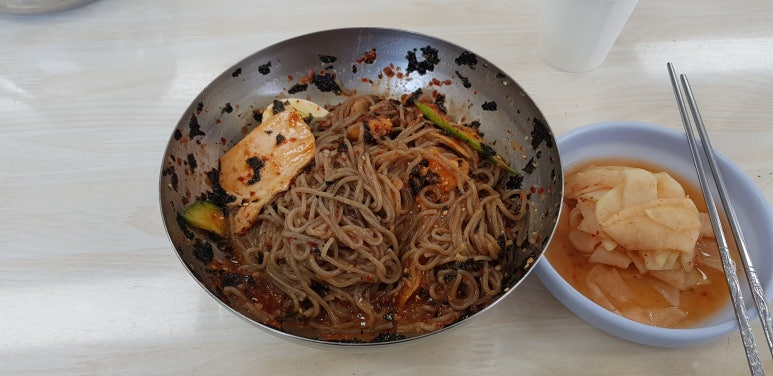Traveling through Korea’s quiet countryside always feels like pressing pause on a fast-paced life. In the winding roads of Gangwon-do, between sleepy markets and misty hills, I found a small restaurant that serves only one dish—but it’s a dish done to perfection. Sangdong Makguksu (상동막국수) in Yeongwol is not just a place to eat; it’s a reminder of how powerful simple, honest food can be. When tradition is respected and quality is prioritized over quantity, even a single bowl of noodles can tell a story.

A Cultural Icon in a Humble Bowl
Makguksu, or Korean buckwheat noodles, is more than a summertime dish in Gangwon-do—it’s a culinary expression of the region’s agricultural roots and humble lifestyle. Historically, the mountainous terrain of Gangwon Province was better suited to growing buckwheat than rice, which is why dishes like makguksu became staples. They’re known for being light yet filling, simple yet satisfying. At Sangdong Makguksu, this history isn’t written on a plaque—it’s tasted in every bite. The restaurant, open since the early 1970s, has become a quiet icon in Yeongwol, serving generations of locals and welcoming travelers who are lucky enough to find it.

A One-Dish Philosophy Rooted in Confidence
When a restaurant offers only one dish, it does so with confidence. Sangdong Makguksu doesn’t distract you with side menus, set options, or seasonal specials. What you see is what you get: a generous bowl of bibim makguksu (spicy buckwheat noodles), a kettle of chilled broth on the side, and minimal banchan (side dishes). But within this simplicity lies remarkable attention to detail. The noodles are handmade daily, firm yet tender, and naturally aromatic from their high buckwheat content. They’re slightly grainy in texture, which makes them absorb the sauce beautifully.
The sauce is mild, with just enough heat from gochujang and balance from vinegar, sugar, and sesame oil. It’s not overwhelming—just flavorful enough to elevate the noodles while still letting the ingredients shine. You can enjoy the noodles mixed dry, or pour in the cold broth to transform it into mul makguksu, a more refreshing version perfect for warm days. I ended up trying it both ways and couldn’t decide which I liked more.

The Flavor of Home and Hospitality
I arrived just before noon, hoping to beat the lunch crowd. The building looked modest—nothing fancy, just a clean entrance and handwritten signs taped to the window. Inside, the air was cool and quiet, with soft chatter coming from two tables near the window. A woman who I assumed was the owner greeted me with a kind smile. She asked if I’d been here before and then walked me through how to mix the noodles, when to add the broth, and how the flavor would change depending on how long it sat.
When my food arrived, it looked like a bowl of tradition. The noodles were carefully laid, topped with finely sliced cucumbers, pickled radish, half a boiled egg, and a sprinkle of sesame seeds. I added a little broth and stirred gently, watching the ingredients meld into a soft red hue. The first bite was earthy, cool, and deeply comforting. With every mouthful, I found myself slowing down. There was no music, no fancy plating—just honest food in a quiet room with kind people.
A Taste of Yeongwol’s Rhythm
Yeongwol is a town best described as quietly charming. It doesn’t overwhelm you with sights or sounds—it welcomes you gently. Before arriving at the restaurant, I had wandered through Seobu Market, which sits nearby. Elderly vendors sold fresh greens, wild herbs, and homemade kimchi in baskets. A middle school student helped her grandmother sell tofu. That ordinary scene stayed with me as I ate, reminding me that places like Sangdong Makguksu aren’t built for show—they’re part of everyday life.
After finishing my meal, I took a short stroll along a nearby riverside path, letting the cool breeze balance the heat of the gochujang still lingering on my lips. The entire experience—from the market to the meal to the walk—felt like a pocket of calm in a world that’s always rushing.

When Less Truly Is More
What impressed me most about Sangdong Makguksu wasn’t just the food—it was the philosophy behind it. There was no rush. Even though a few people had begun to queue up by the time I finished, the staff never pressured anyone to leave quickly. They moved at their own pace—efficient but relaxed. Everything about the experience encouraged me to appreciate the moment: the food in front of me, the quiet joy of a meal alone, and the pride of a family running a business rooted in their region’s heritage.
It reminded me of the beauty in restraint. In a time when many restaurants compete to be trendier, bigger, or more Instagram-worthy, Sangdong Makguksu focuses on being consistent, warm, and real. And that’s what makes it stand out.
Menu, Prices, and Practical Information
If you’re heading to Gangwon-do and want to try something distinctly regional, makguksu should be high on your list. And if you’re in Yeongwol, Sangdong Makguksu is the place to try it.
Menu and Prices (KRW, as of 2025):
- Makguksu (Spicy Buckwheat Noodles): 10,000 KRW
- Additional Noodle (Sari): 3,000 KRW
Restaurant Information:
- Name: Sangdong Makguksu (상동막국수)
- Address: 6 Eunhaengnamu-gil, Yeongwol-eup, Yeongwol-gun, Gangwon-do, South Korea
- Phone: +82-33-374-4059
- Hours: 10:30 a.m. – 3:30 p.m. (Closed Wednesdays)
- Parking: On-site parking available; additional parking at Seobu Market nearby
- Tip: Arrive early to avoid the lunch rush. The restaurant fills quickly by noon but turns over fast due to the simple menu.
If you ever find yourself traveling through Gangwon-do and want a taste of Korean culinary heritage without the tourist flair, Sangdong Makguksu is the perfect stop. It’s humble, heartfelt, and wholly satisfying.
